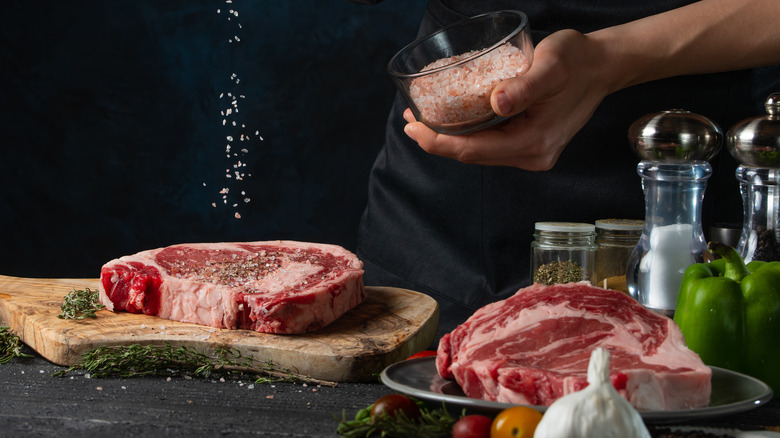How To Tell If Steak Has Gone Bad
Few things appeal to our primal hunter-gatherer heritage quite like eating a thick, juicy steak, preferably one cooked outside over a crackling fire. But since steak, like all meats, is perishable, and since modern humans don't always have the instinctive knowledge of our ancient forebears to know when good meat has gone bad, here are a few helpful tips to ensure that New York strip you're about to throw on the barbie (or grill) is still good to go.
The first thing to check, of course, is the expiration date. But as Smoked BBQ Source notes, it's important to differentiate between the "sell by" and "use by" dates. The former is a guide for the butcher or supermarket with a built-in time cushion for consumers, the latter indicates how long you actually have to cook or freeze the steak before it goes bad, or spoils. According to the U.S. Food and Drug Administration, steaks can be safely frozen for six months to a year, or refrigerated for up to five days. Don't refrigerate beyond the "use by" date.
Using senses like sight and smell to evaluate steaks
If checking the expiration date qualifies as common sense, so too does using your eyes, nose, and sense of touch to evaluate the condition of your steaks prior to preparation. Per Food Fire Friends, steak that's going bad often looks discolored, appearing brown or gray instead of the healthy red color one would expect. But sight alone may not always be conclusive, so Steak Revolution recommends touching or examining the texture of the steak as well. If it's slimy or slick — or worse yet, moldy — that's a sure sign that the steak is going bad and should be thrown out. Utilizing your sense of smell can also help. If you catch a whiff of something that smells like ammonia, bad news: The steak is definitely spoiled.
What are the best practices to keep your steak fresh for as long as possible? According to Chicago Steak Company, removing the original packaging and vacuum sealing helps preserve steaks significantly longer when freezing. FoodSaver claims this is because vacuum sealing is better at preventing freezer burn, and also protects the integrity of food for longer. When refrigerating steaks, the FDA recommends keeping the fridge at 40 degrees Fahrenheit or cooler for maximum food safety.

